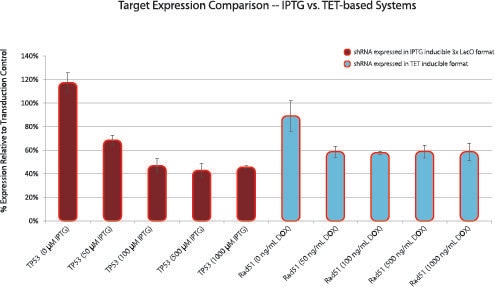Inducible shRNA Vectors
Dial into the latest development from the RNAi Consortium (TRC)
Constitutively expressed shRNAs are useful for most RNAi needs, but further characterization often requires the ability to tune gene expression. Regulating expression is especially important when studying essential and lethal genes. We are proud to offer IPTG-inducible shRNA vectors as the latest development from our continued partnership in TRC. Trust in MISSION® Custom Services to create the perfect clone to fit your research.
Note: It is important to perform an initial experiment with your shRNA clones using the MISSION® pLKO constitutive shRNA vector, prior to beginning your IPTG inducible shRNA experiment. You should measure knockdown of at least 70% at the mRNA level via qRT-PCR before moving into the IPTG inducible shRNA system.
Standard Product Offering
Our service includes: shRNA design, cloning, sequence verification, DNA quantitation and titer determination (when ordering lentivirus). The order is typically shipped 4–6 weeks from the time the order is placed. Customized titer, volume and packaging are all available upon request.
The control viruses in the table above are manufactured and kept on the shelf. They will be shipped upon order.
Standard DNA orders receive a total of 1 µg of purified plasmid DNA in Tris-EDTA (TE) buffer at a concentration 20 ng/µL.
Standard lentivirus orders receive 200 µL (4 x 50 µL aliquots) at a minimum titer of 1 x 106 TU/mL. We routinely deliver virus at titers higher than 1 x 107 TU/ml.
Why Use IPTG-Inducible shRNA?
- Temporally-controlled gene silencing useful for lethal gene knockdown
- Proven to work in vivo and in vitro
- Single vector system for effective inducible knockdown
- Fast response time of IPTG induction
- Tight regulation and high induction of shRNA expression
- Available in the widely used TRC vector backbone
- Lentiviral delivery increases the number of targetable cell lines
- Developed at the Broad Institute by the TRC
Customized to your specifications
Vector: 1x LacO & 3x LacO
Titer: 1x106 – 1x109 TU/mL
Volume: 200 µL – 10 mL
Sequence: Choose any TRC clone or Custom Sequence
Ordering
Orders and inquiries can be handled in one of three ways:
- Contact your local sales representative
- Send us an e-mail at MISSIONRNAi@sial.com
- Fill out our online request form
Performance
The pLKO vector has been redesigned to contain a LacI (repressor) and a modified human U6 shRNA promoter with LacO (operator) sequences. In the absence of IPTG (isopropyl-ß-D-thio-galactoside), an analogue of lactose, LacI binds to LacO preventing expression of the shRNA. When IPTG is present, the allosteric LacI repressor changes conformation, releasing itself from lacO modified human U6 promoter, and subsequently allows expression of the shRNA.
We are proud to offer two different IPTG inducible vectors for your research. The preferred inducible vector, pLKO_IPTG_3xLacO, contains three lac operon sequences (two in the U6 promoter and one 3' of the promoter) affording both tight regulation and great gene silencing. Whereas the pLKO_IPTG_1xLacO vector contains a single lac operon sequence in the U6 promoter, which allows for an advantage to shRNA expression, but looser control of the promoter when not induced.

Figure 1.The data demonstrates the general performance of the 1xLacO and 3xLacO vectors in comparison to an equivalent constitutive design. Choose the vector that will work best for your application.

Figure 2.Comparison of IPTG- and TET-inducible shRNA-mediated knockdown.
p53 and Rad51 were targeted for knockdown with either IPTG- or TET-based inducible systems, respectively. After optimization of viral MOI and shRNA sequence used, an induction curve was performed for each target using varied concentrations of IPTG or DOX, as indicated. Induction of shRNA expression was carried out for 48 hours, after which total RNA was harvested from the treated cells and target expression was measured by qRT-PCR. Percent expression shown is relative to untreated wild-type cells (HepG2 for p53 and A549 for Rad51), and is normalized to cyclophilin A expression. When no IPTG is present in the culture media, knockdown was not observed, yet very low levels of DOX were able to induce shRNA-mediated knockdown of Rad51. Further, upon induction with varied concentrations of IPTG, a more dynamic range and higher overall knockdown was observed, indicating higher sensitivity relative to TET-induced knockdown of Rad51.
Available Inducible shRNA References

Inducible shRNA References
IPTG Inducible shRNA References
To continue reading please sign in or create an account.
Don't Have An Account?